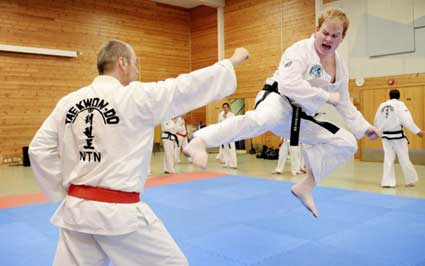Some great tips on teaching visually impaired people from Torfinn Katla Opedal!
Instructing visually impaired people.
 Here are some tips on what you should and should not do when instructing visually impaired.
Here are some tips on what you should and should not do when instructing visually impaired.
• Visual interpretation. Learn and practice how to explain what sighted people see. Avoid terms like "this" and “that”. "Grab that arm with this arm, before moving that leg behind his." will likely be of little or no value to a student unable to see any of the objects mentioned in the instruction. Give a detailed description like “Grab the left arm from the top with your own left arm, before moving your right leg behind the opponents left leg.”
• Breaks. When you can't see, you must compensate with other senses. This takes a lot of energy. Breaks are needed.
• Use your name. When approaching your student let them know who is talking.
• Don’t be afraid of asking questions. Ask the person what works for them, ask them if it is okay for you to guide them in different ways, and how they prefer it. Personal zones are just as important to blind people as it is to the sighted.
• Explain the room. When they first get to the training hall you should explain how it is shaped, where the exits are, where there are windows, where there are poles etc.
• Do not place them near things they can crash into without telling them and helping them avoid these things.
• If it is okay for the student you can move their limbs in the correct movements so they can feel how it should be done.
• Practise turns gradually. Do not start by turning 180 degrees. Start by turning 90 and when they have mastered it you can move on to 180.
• Try to avoid loud music as it can easily disorient the practitioner.
• Remember that identical diagnosis doesn’t mean identical personalities and needs.
This is a list of tips that I have found to be useful. There are probably things I haven't thought of that you might figure out, but this is a guiding start.


Thanks Iain for sharing Torfinn Katla Opedal article.
This is great set of tips, I never had oportunity to teach visually impaired students, but I can imagine how difficoult have to be to describe the techniques. I had a pleasure to train with two blind budo students one in judo, amzing feel of the oponents body, I was amazed how easy he felt my intension. Other person was a blind Iaido guy, honestly I dont know how he was able to use the sharp sword around others. More impresive was that others had full trust in his skills, trully breath taking spectacle to watch.
Kind regards
Les
Hi All,
I've just delivered four sessions to a small visually impaired group and would agree entirely with the above. I would add though that describing the room is good, but walking the room is better. I placed a small radio/cd player near the fire exit to identify one end of the room. We were doing grappling and throws for some of the session so it would be easy to get disoriented, the music helped to identify which part of the room they were in. I would also agree with the need for regular breaks, after doing a short visually impaired training course and being led around a busy city centre while blind folded, I can testify how absorbing it can be to use other senses to compensate for sight loss. My brain was literally clamouring for information, noises, sensations through my feet for terrain, where my guide was in relation to me, anything I could sense was trying to replace my sight and it was immediate, there was no period of time to get used to the change. I would highly recommend working with less able groups, the challenge is considerable but the rewards are greater. I must also thank Sensei John Johnson for allowing me to join him on one of his disabled Karate sessions to see how he works with less able students and then tailors their training to their abilities.
Regards,
Malcolm
Got to second that. John is very knowledge on this topic (and may other topics!). A great teacher.
All the best,
Iain